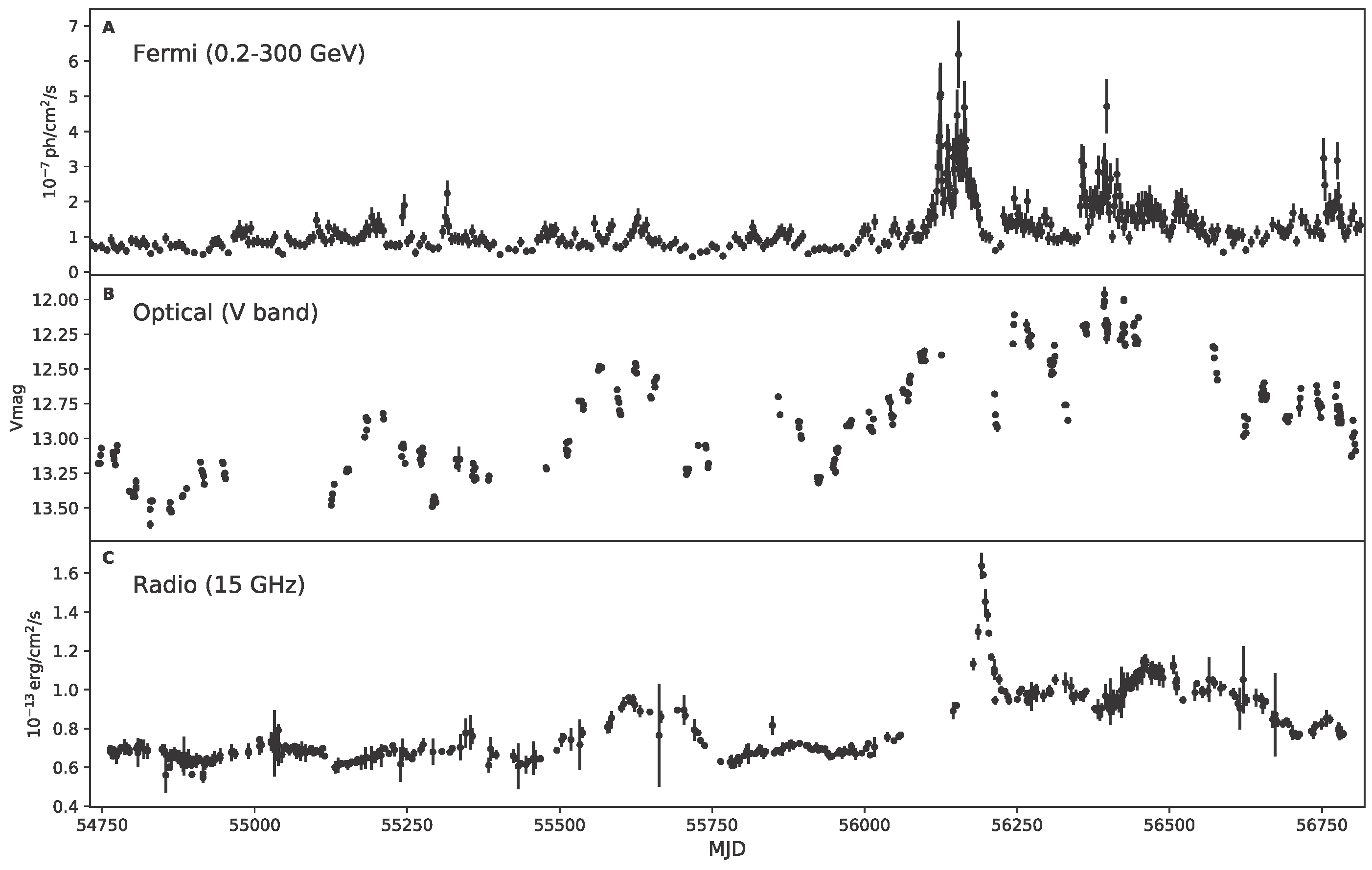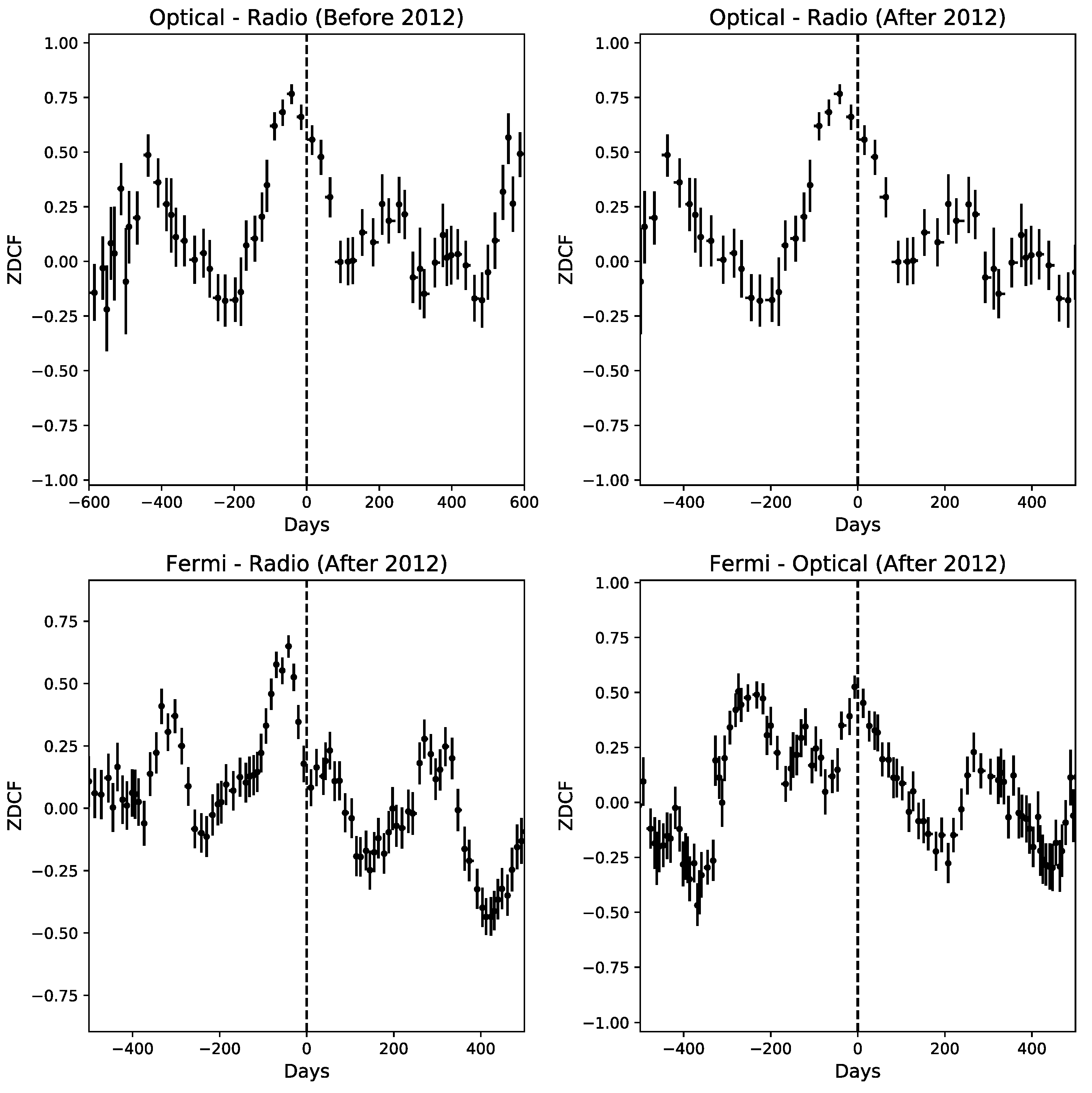Long-Term Multi-Band and Polarimetric View of Mkn 421: Motivations for an Integrated Open-Data Platform for Blazar Optical Polarimetry
Abstract
:1. Introduction
2. The Dataset
3. Analysis
3.1. Time Lags
3.2. SED Fitting
3.3. Polarisation Measurements
4. Discussion and Conclusions
Acknowledgments
Author Contributions
Conflicts of Interest
References
- Urry, M.; Padovani, P. Unified Schemes for Radio-Loud Active Galactic Nuclei. Publ. Astron. Soc. Pac. 1995, 107, 803–845. [Google Scholar] [CrossRef]
- Sikora, M.; Begelman, M.; Rees, M.J. Energetic and radiative constraints on highly relativistic jets. Astrophys. J. 1994, 429, L57–L60. [Google Scholar]
- Mucke, A.; Protheroe, R.J. A proton synchrotron blazar model for flaring in Mrk 501. Astropart. Phys. 2001, 15, 121–136. [Google Scholar] [CrossRef] [Green Version]
- Petropoulou, M.; Dimitrakoudis, S.; Padovani, P.; Mastichiadis, A.; Resconi, E. Photohadronic origin of gamma-ray BL Lac emission: Implications for IceCube neutrinos. Mon. Not. R. Astron. Soc. 2015, 448, 2412–2429. [Google Scholar] [CrossRef]
- Vercellone, S.; Chen, A.W.; Vittorini, V.; Giuliani, A.; D’Ammando, F.; Tavani, M.; Donnarumma, I.; Pucella, G.; Raiteri, C.M.; Villata, M.; et al. Multi-wavelength Observations of 3C 454.3. I. The AGILE 2007 November campaign on the “Crazy Diamond”. Astrophys. J. 2009, 690, 1018–1030. [Google Scholar] [CrossRef]
- Aharonian, F.; Akhperjanian, A.G.; Anton, G.; Barres de Almeida, U.; Bazer-Bachi, A.R.; Becherini, Y.; Behera, B.; Bernlöhr, K.; Boisson, C.; Bochow, A.; et al. (The HESS Collaboration). Simultaneous Observations of PKS 2155-304 with HESS, Fermi, RXTE, and Atom. Astrophys. J. 2009, 696, L150–L155. [Google Scholar] [CrossRef]
- Donnarumma, I.; Vittorini, V.; Vercellone, S.; Del Monte, E.; Feroci, M.; D’Ammando, F.; Pacciani, L.; Chen, A.W.; Tavani1, M.; Bulgarelliet, A.; et al. The June 2008 Flare of Mkn 421 from Optical to TeV Energies. Astrophys. J. 2009, 691, L13–L19. [Google Scholar] [CrossRef]
- Larionov, V.; Jorstad, S.G.; Marscher, A.P.; Smith, P.S. Polarization Vector Rotations: Real, Spurious, Hidden and Imaginary. Galaxies 2016, 4, 43. [Google Scholar] [CrossRef]
- Punch, M.; Akerlof, C.W.; Cawley, M.F.; Chantell, M.; Fegan, D.J.; Fennell, S.; Gaidos, J.A.; Hagan, J.; Hillas, A.M.; Jiang, Y.; et al. Detection of TeV photons from the active galaxy Markarian 421. Nature 1992, 358, 477–478. [Google Scholar] [CrossRef]
- Giommi, P. Multi-frequency, multi-messenger astrophysics with Blazars at ASDC and BSDC. In Proceedings of the AIP Conference Proceedings, Yogyakarta, Indonesia, 11–13 November 2015; Volume 1693. [Google Scholar] [CrossRef]
- Sahakyan, N.; Gasparyan, S. High-energy gamma-ray emission from PKS 1444 + 25. Mon. Not. R. Astron. Soc. 2017, 470, 2861–2869. [Google Scholar] [CrossRef]
- Alexander, T. Is AGN Variability Correlated with other AGN Properties?—ZDCF Analysis of Small Samples of Sparse Light Curves. In Astronomical Time Series; Maoz, D., Sternberg, A., Leibowitz, E.M., Eds.; Astrophysics and Space Science Library; Springer: Dordrecht, The Netherlands, 1997; Volume 218, pp. 163–166. [Google Scholar]
- Edelson, R.A.; Krolik, J.H. The discrete correlation function—A new method for analysing unevenly sampled variability data. Astrophys. J. 1988, 333, 646–659. [Google Scholar] [CrossRef]
- Alexander, T. Improved AGN light-curve analysis with z-transformed discrete correlation function. arXiv, 2013; arXiv:1302.1508. [Google Scholar]
- Jermak, H.; Steele, I.A.; Lindfors, E.; Hovatta, T.; Nilsson, K.; Lamb, J.B.; Mundell, C.; Barres de Almeida, U.; Berdyugin, A.; Kadenius, V.; et al. The RINGO2 and DIPOL Optical Polarisation Catalogue of Blazars. Mon. Not. R. Astron. Soc. 2016, 462, 4267–4299. [Google Scholar] [CrossRef]
| 1 |




© 2017 by the authors. Licensee MDPI, Basel, Switzerland. This article is an open access article distributed under the terms and conditions of the Creative Commons Attribution (CC BY) license (http://creativecommons.org/licenses/by/4.0/).
Share and Cite
Barres de Almeida, U.; Fraga, B.M.O.; Giommi, P.; Sahakyan, N.; Gasparyan, S.; Brandt, C.H. Long-Term Multi-Band and Polarimetric View of Mkn 421: Motivations for an Integrated Open-Data Platform for Blazar Optical Polarimetry. Galaxies 2017, 5, 90. https://doi.org/10.3390/galaxies5040090
Barres de Almeida U, Fraga BMO, Giommi P, Sahakyan N, Gasparyan S, Brandt CH. Long-Term Multi-Band and Polarimetric View of Mkn 421: Motivations for an Integrated Open-Data Platform for Blazar Optical Polarimetry. Galaxies. 2017; 5(4):90. https://doi.org/10.3390/galaxies5040090
Chicago/Turabian StyleBarres de Almeida, Ulisses, Bernardo M. O. Fraga, Paolo Giommi, Narek Sahakyan, Sargis Gasparyan, and Carlos H. Brandt. 2017. "Long-Term Multi-Band and Polarimetric View of Mkn 421: Motivations for an Integrated Open-Data Platform for Blazar Optical Polarimetry" Galaxies 5, no. 4: 90. https://doi.org/10.3390/galaxies5040090





